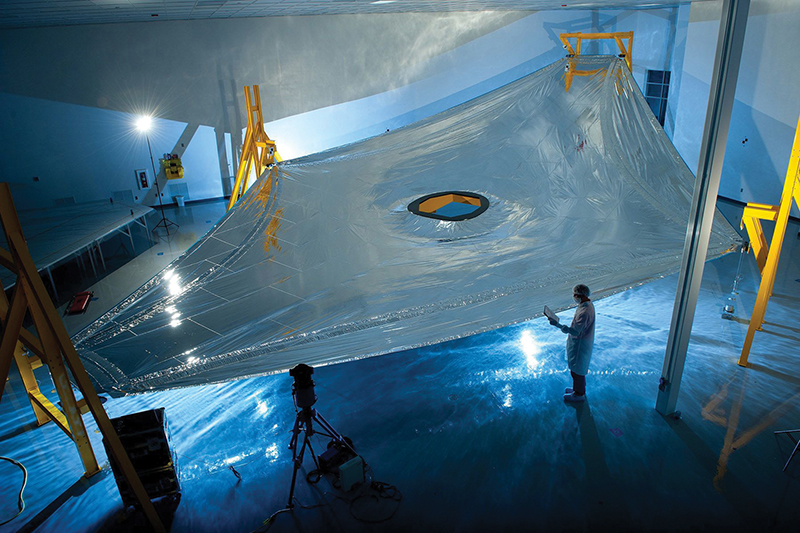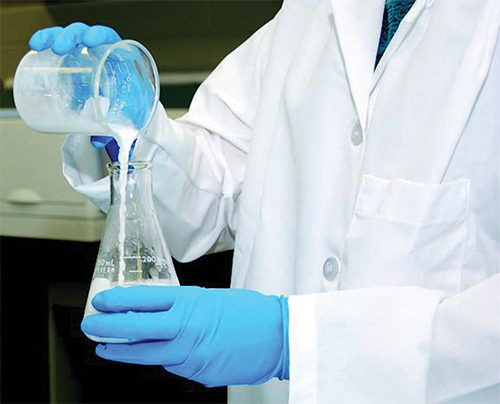
Thin Films Protect Electronics from Heat and Radiation
NASA Technology
Back in 1972, Anne St. Clair worked side by side with Langley Research Center colleague Vernon Bell as part of NASA’s research and development efforts to create robust materials for space applications. Bell synthesized new building blocks for high performance polyimides while St. Clair adapted them to make thin films—very thin materials.
As a unique substance known for its heat- and chemical-resistant properties, present-day polyimides are in everything from laptops to kitchen toasters. For NASA, polyimides are useful in space because they can withstand extreme temperatures and radiation.
After working with almost 100 different polyimide structures, St. Clair noticed that a few of the resulting films were nearly colorless. This characteristic was only mildly interesting to Bell, but St. Clair thought it could be extremely beneficial for NASA. In space, color causes heat absorption, which can destroy structures and electronics.
St. Clair decided to explore her suspicion about the value of color-free polyimides. She collaborated with Langley colleague Wayne Slemp and Marshall Space Flight Center to characterize the substances. The results confirmed her suspicion, finding that the color-free polyimides were more stable in simulated space environments.
SRS Technologies (now a part of ManTech International Corporation) worked with St. Clair and Marshall Space Flight Center to create demonstration pieces for space applications utilizing the thin film. They were successfully proven, and St. Clair’s polyimides became known as Langley Research Center Colorless Polyimide 1 and 2 (LaRC-CP1 and LaRC-CP2).
Technology Transfer
In the late 1990s, SRS exclusively licensed the polyimides from Langley. According to Garrett Poe, program director at ManTech International Corporation, the company soon learned how to make CP1 and CP2 more effectively. “We’ve made several manufacturing improvements with regard to batch size, batch yield, reproducibility, and molecular weight,” he says.
In 2007, ManTech International acquired SRS Technologies, which became ManTech SRS Technologies Incorporated. A couple of years later, ManTech separated the group and renamed it NeXolve Corporation, which is based in Huntsville, Alabama.
NeXolve vice president, Jim Moore, explains that the company was working on solar thermal applications at the time when it licensed the technology, and needed a thin film capable of surviving the extreme conditions of space. “The polyimide structure was intended to be folded into a small package, deployed in space to create a large mirror, and then reflect the sun’s energy down to the absorber so it could be used as propellant,” he says. “Using CP1, we could have a mirror that was made out of polyimides.”
Benefits
Today, NeXolve is a leading provider of polyimide thin film products not only to NASA, but to commercial customers including Boeing, Lockheed Martin, and Northrop Grumman.
One of NeXolve’s larger NASA projects is the James Webb Space Telescope. The company is providing the five-layer sunshields that will expand to nearly the size of a tennis court when in space.
“We’ve worked with NASA on solar thermal propulsion, inflatable concentrators, and solar sails,” says Garrett. “Most polymer materials start decomposing above 200 or 250 °C. We test our materials to 300 °C. If it withstands that, we have confidence it can withstand temperatures it will see on orbit,” says Poe.
NeXolve is also working with government and commercial entities that are developing applications that require lightweight, thin film optics for telescopes. “We use LaRC-CP1 to make transmissive membrane optics or reflective membrane optics,” says Poe. “We combine it with another technology we have to manufacture membrane mirrors. We can make the same surface as a glass mirror, but using a thin plastic film that is very light.”
The company also produces a CP1-coated copper foil for use as in thermal control. “In spacecraft insulation, it’s a multilayer insulation material,” describes Poe. “The blanket is comprised of several layers of films, some of which may be made with CP1 with aluminum coating, for example.”
Over the years, NeXolve has demonstrated CP1 to have stable physical and electrical properties over a range of temperatures and environments. Because it has significantly lower moisture uptake than traditional polyimides, the substance is useful on flexible printed circuit boards for electronics. “The more electronics there are in an area, the more things heat and expand and contract. The more they expand and contract, the more they are subject to moisture expansion, so if you have a material that doesn’t absorb much moisture, like ours, it is beneficial,” says Poe.
The company also supplies its spinoff technology to a leading provider of test solutions for coating electronic test hardware, and is in discussions with a supplier of disk drive components. “We have worked to develop materials to incorporate into suspension assemblies for hard disk drives,” says Moore.
After 40 years of innovation, this one NASA technology not only provides benefits on Earth but continues to influence the future of space exploration. The company recently proposed to use LaRC-CP1 as part of a special kind of photovoltaic technology which could enable lightweight cells for space-based solar power.

NASA researchers discovered unique heat-resistant substances that were nearly colorless when made into thin films. Proven to be stable in space environments, a private company licensed the NASA technology. Image courtesy of NeXolve Corporation

NeXolve Corporation is using NASA-derived thin films to construct the five-layer sunshields—one of which is shown here on a test fixture—for the James Webb Space Telescope. The company also provides spinoff products for coating electronic test hardware and for incorporating into hard disk drives. Image courtesy of Northrop Grumman Aerospace Systems













